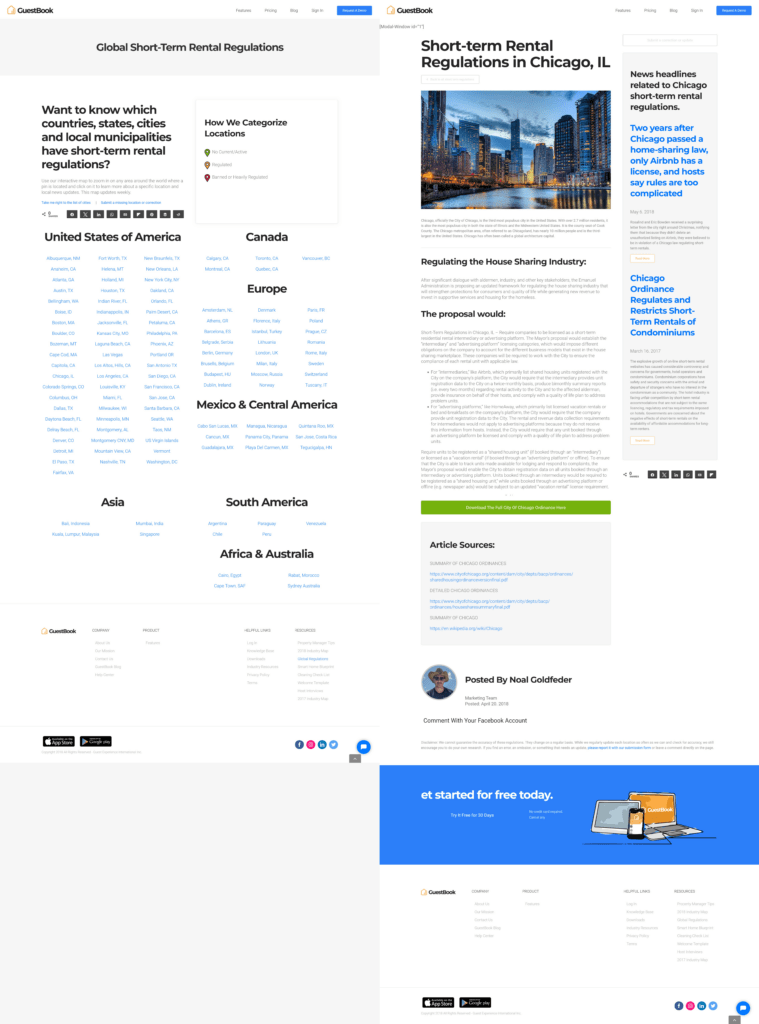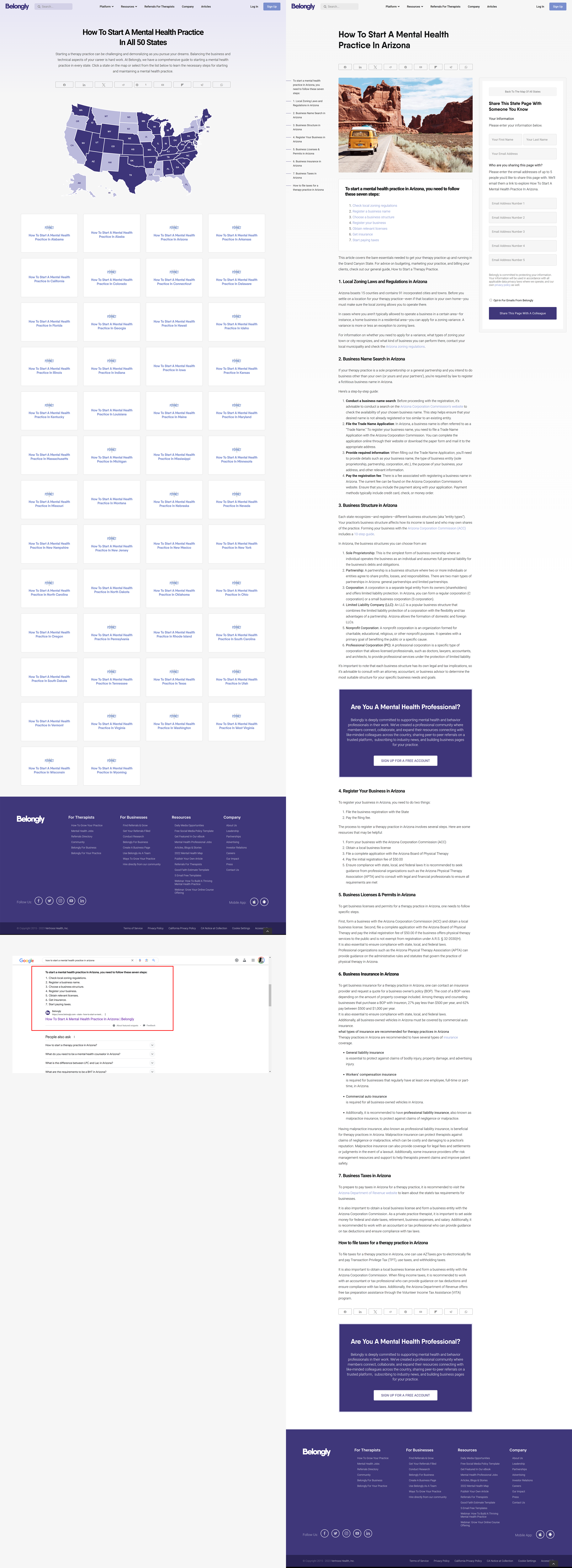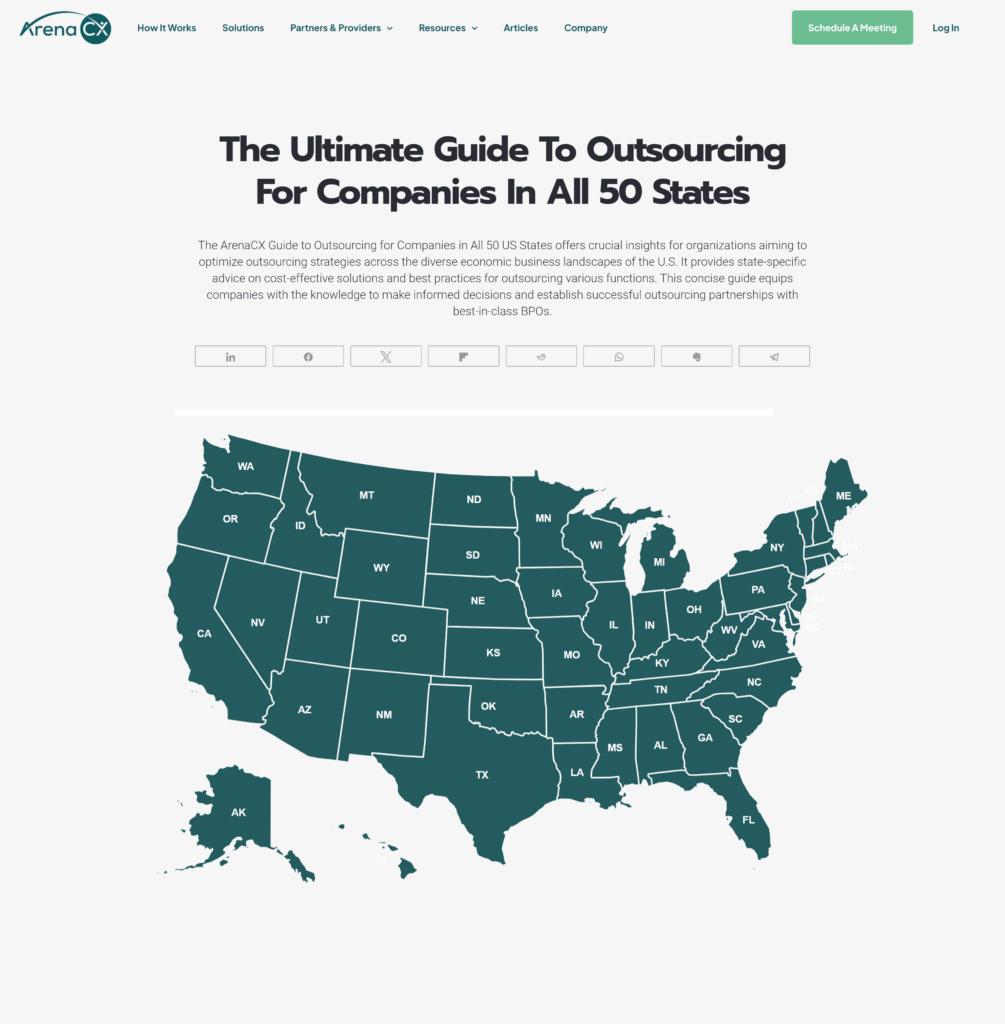One of my most trusted mentors once told me, “If you want to own an industry (from a marketing standpoint), map it.” At the time, he was referring to creating hyper-detailed downloadable, interactive PDF maps of industries people are interested in and willing to trade their contact information for. Now, I believe a more interesting strategy involves using interactive maps to own search terms such as “How to start a mental health practice in [Insert State Name],” “Airbnb regulations in [Insert key market location name],” “What happens if my child is injured in [Insert location],” or “Outsourcing advice for businesses in [Insert City or State Name].”
By building visual maps of locations paired with textual lists that link to content-rich landing pages offering advice and guidance, we can achieve four crucial objectives:
Answer Questions That People Are Searching For
Interactive maps can capture immediate audience intent by providing answers to specific questions. For instance, a map detailing mental health practice regulations by state can attract mental health professionals seeking to start a practice in a particular location. This strategy leverages the high search volume for localized queries, directing traffic to your site by providing the precise information users seek.
Dominate Local Search
Local SEO is pivotal for businesses targeting specific geographical areas. Naming conventions, mapping structures, H1 tags, URL permalinks, and page hierarchies should be oriented toward local SEO. For example, creating a page titled “Airbnb Regulations in San Francisco” with relevant H1 tags and permalinks can significantly improve local search rankings. This approach ensures that your content is easily discoverable by users searching for information about a particular location.
Example: According to Moz, localized content that includes city and state names within the text and meta tags can significantly boost local search rankings.
Engage Users with Interactive Content
Interactive maps are inherently engaging. They allow users to explore information visually and intuitively. By pairing maps with detailed content on landing pages, you can enhance user experience and keep visitors on your site longer. This engagement can reduce bounce rates and increase the likelihood of conversions.
Example: HubSpot’s research indicates that interactive content like maps and infographics can generate twice as many conversions as static content.
Pair Content with Conversion Mechanisms
High-quality, sought-after content should be paired with other engagement mechanisms and conversion strategies. This includes linking to additional content, embedding conversion forms, using clear calls-to-action (CTAs), and offering relevant resources. For instance, a landing page about “Outsourcing Advice for Businesses in [Insert City or State Name]” can include CTAs for downloading an outsourcing checklist, signing up for a newsletter, or requesting a consultation.
Example: Neil Patel’s guide on conversion rate optimization emphasizes the importance of strategically placed CTAs and engaging content to boost conversions.
Mapping Strategies for Marketing Success
Identify High-Value Search Terms
Begin by researching high-value search terms related to your industry and target locations. Tools like Google Keyword Planner and Ahrefs can help you identify keywords with high search volume and low competition. Focus on long-tail keywords that are specific to your niche and location.
Create Interactive Maps
Use tools like Google My Maps, Mapbox, or Tableau to create interactive maps. Ensure that these maps are detailed and user-friendly. Include markers, annotations, and layers that provide valuable information relevant to your target audience.
Develop Content-Rich Landing Pages
Each interactive map should link to a content-rich landing page. These pages should provide comprehensive information, answering the specific questions users are searching for. Use a strategic page structure with clear headings, subheadings, and bullet points to make the content easy to read and navigate.
Optimize for Local SEO
Incorporate local SEO best practices into your landing pages. This includes using location-specific keywords in titles, headers, and meta descriptions. Ensure that your URL structure reflects the geographical focus of your content.
Example: A study by BrightLocal found that 78% of local mobile searches result in an offline purchase, highlighting the importance of local SEO in driving business outcomes.
Implement Conversion Strategies
Enhance your landing pages with conversion strategies. Include clear and compelling CTAs, conversion forms, and offers. Use pop-ups, slide-ins, and banners to capture leads and encourage user interaction.
Example: Neil Patel’s guide on conversion rate optimization emphasizes the importance of strategically placed CTAs and engaging content to boost conversions.
Competing with Companies with Larger Budgets
Using interactive maps can be a game-changer for companies competing in search rankings against larger companies with substantial budgets. Here are a few examples of how this strategy has worked in practice:
Example 1: GuestBook
When I was running growth at GuestBook, we were trying to rank for “Airbnb property management software.” Quickly, I realized that we couldn’t compete with much larger companies dominating the paid and sponsored rankings. Instead, I devised a strategy to capture the same audience—short-term rental property managers—before they even knew they needed software. I focused on answering their burning questions about short-term rental regulations in the city/state where they started their business. Once we attracted them with this valuable information, we converted them into software users. This project increased our web traffic by over 10,000 users per month.
Example 2: Belongly
At Belongly, where I currently head up growth, our audience comprises mental health professionals. We build software and run a community to improve the business of therapy and ensure people are better matched with therapists. We saw a significant impact by creating a fully interactive map and 50 state-specific pages advising on how to start a mental health practice in each state. This approach alsoresulted in a 10,000-user-per-month increase in web traffic.
Example 3: ArenaCX
At ArenaCX, where I’m running growth, we aim to capture and dominate the search traffic of buyers exploring outsourcing for key business functions. We created a 50-state guide offering outsourcing advice to businesses across the country. Although the results are TBD, we are already ranking number one for states like Alaska just a few weeks after launch. This indicates that this strategy is reliable and likely to yield results similar to our previous successes.
The Importance of Engagement Optimization (EO)
While SEO is crucial for attracting traffic, Engagement Optimization (EO) is essential for converting that traffic into leads and customers. EO focuses on enhancing user experience and encouraging interaction with your content. Here’s how to integrate EO into your mapping strategy:
Interactive Content
Use interactive maps to engage users. Allow them to explore information visually and intuitively. Interactive elements keep users on your site longer and make the experience more enjoyable.
Personalized User Experience
Tailor your content to meet the needs and preferences of your audience. Use data analytics to understand user behavior and preferences, then adjust your content and interactions accordingly.
Clear and Compelling CTAs
Place clear and compelling calls to action (CTAs) strategically throughout your content. Ensure they stand out and guide users to the desired actions, such as downloading a resource, signing up for a newsletter, or requesting a consultation.
Engagement Mechanisms
Use engagement mechanisms like pop-ups, slide-ins, and banners to capture leads. These elements should be designed to be helpful and not intrusive, providing additional value to the user.
Content Interlinking
Link-related content to keep users engaged with your site. Provide easy navigation to additional resources, articles, or guides that can help answer more of their questions.
Feedback and Interaction
Encourage user feedback and interaction through comments, surveys, and social media. This will increase engagement and provide valuable insights into your audience’s needs and preferences.
Conclusion
Mapping your way to market domination involves more than just creating visual representations of locations. It’s about strategically using these maps to capture audience intent, dominate local search, engage users with interactive content, and drive conversions. By following these steps, you can leverage the power of interactive maps to enhance your marketing efforts and achieve business success.
Remember, if you map it, they will come—and with the right strategies in place, they will convert.
Ready to Map Your Way to Marketing Success?
Unlock the full potential of interactive maps to dominate local search and drive conversions. Schedule a meeting with me to create a custom interactive map strategy tailored to your business goals. Don’t miss out on the opportunity to transform your marketing efforts, dominate search and capture new conversions —Book Your Consultation Now!
Keep Reading
Want more? Here are some other blog posts you might be interested in.
The MVP—Minimum Viable Product—has become gospel in startup circles. Build fast, test fast, fail fast. But in today’s crowded market, viability ...
The startup myth goes like this: work 20-hour days, pivot constantly, chase the high of the new. That’s what makes a ...
Most founders build their first leadership teams for speed, comfort, and alignment. Understandably, you’re strapped for time and need people who ...
For founders and growing companies
Get all the tips, stories and resources you didn’t know you needed – straight to your email!








